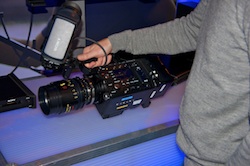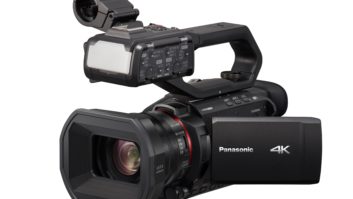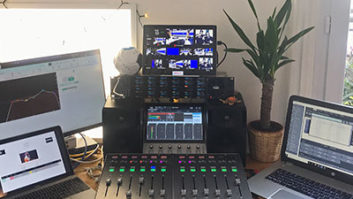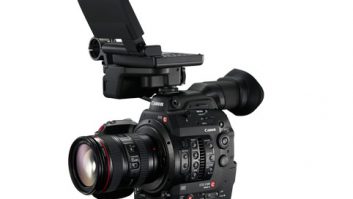
With the introduction of the new PMW-F5 and PMW-F55 4K cameras, Sony has started the roll-out of its new, more efficient, mid-range codec: XAVC. This has been designed for 4K, and will offer both intra frame and Long GoP options. It will also allow higher frame rate recording at 1080p.
Sony decided to offer the F5 and F55 as multi-format cameras, rather than just XAVC, “so that they would fit within the workflow people want rather than restricting choice,” says Product Specialist Sebastian Leske.
The cameras will support four codecs: XAVC, for high frame rates and 4K, MPEG-2 at 50Mbps, MPEG4 SStP (Sony’s SR Master codec) and Raw 4K “by the switch of a button, depending on what job you want to do,” adds Olivier Bovis, Sony’s head of AV Media.
XAVC is an extension of H.264, using the highest Level 5.2 of the standard, so it is very solid in terms of multi-generational support, he explains. As Sony already had HDCAM SR and Raw on offer, why did it need yet another codec?
“The data rate from an F65 sensor can be as much as 35Gbps, whereas the new SxS Pro+ cards can go up to 1.3Gbps. So, we still need efficient compression to take all that data and package it in a manageable way,” explains Strategic Marketing Manager Peter Sykes. Besides, MPEG-2 simply couldn’t cope with 4K, whereas XAVC cannot only handle higher resolution but higher frame rates.
Raw isn’t seen as a suitable every-day production format as it results in much higher data rates and can’t be used as an interchangeable format. Although Raw offers all the flexibility some productions may need for high-end post production, it is always linked to the camera sensor, which complicates the workflow and makes it less suited to productions that need to use a variety of different cameras.
Open season
The F5 and F55 can record existing 50Mbps or 35Mbps XDCAM HD formats, HDCAM SR (MPEG4 SStp) at up to 220Mbps or 440Mbps or XAVC. Using intra-frame XAVC at 10-bit 4K 4:2:2 requires 240Mbps at 24p or 600Mbps at 60p.
For 10-bit HD 4:2:2, up to 60p, it will record at 200Mbps. It can also deliver proxy 4:2:0 images at low bit rates. Users will be able to choose between 8- and 10-bit recording for both XAVC and MPEG2.
XAVC uses an MXF wrapper, as it is “industry standard and well recognised,” says Sykes, and its implementation is identical to Sony’s MPEG-2 and MPEG-4 SStP MXF OP-1a files.
“It is an enabling technology for a range of products that will emerge from now on,” he adds. “It’s a major part of our plan for our acquisition products. XAVC will become the core codec for applications beyond HD and for higher frame rates.”
“To drive beyond HD we had to develop XAVC,” agrees Leske. “The design is future ready.” It will be able to do 4:4:4 (where it will be able to go up to 1.2Gbps), although the F5 and F55 will use HDCAM SR for 4:4:4 work.
“To go beyond HD we needed a new codec, but it is also useful for 1080 50p and 60p,” he adds. “It uses a different mechanism to keep the highest quality we can. It allocates more bits to the details (like hair) than for flat areas (like a wall).”
XAVC has been developed as an open format, providing a license program for other manufacturers in the broadcast and production industry to develop their own high quality and high frame rate products.
“It is a codec we are going to be using for lots of different applications,” says Sykes. Sony developed the low power consumption chipset used in the cameras. This not only does XAVC, but also processes MPEG2 – and because it is so fast can do both at once, so that the F55 can record both 4K XAVC and XDCAM HD at 50Mbps simultaneously to its SxS Pro+ card.
Currently, it seems that the XAVC workflow will be supported by such manufacturers as: Adobe (CS6 with Rovi Total Code Plug-in installed), Apple, Avid, Grass Valley, Quantel and Sony (Vegas Pro 12) for nonlinear editing; Assimilate, Codex, Colorfront, FilmLight, MTI and YoYotta for on-set dailies; Assimilate, FilmLight and Quantel for colour grading; Rovi for software codec management; and Matrox for a codec board.
By David Fox







